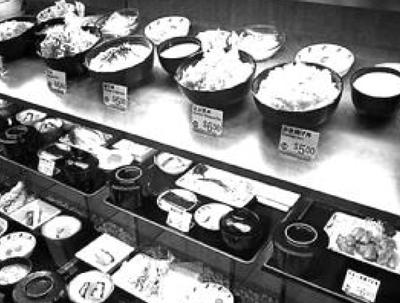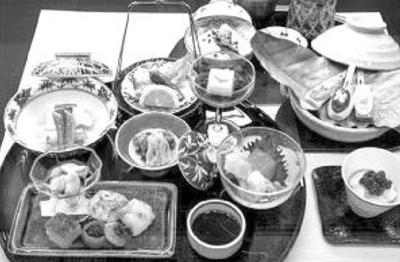美食模型: 不能入口的诱惑
2020-07-04



Host: You know, when you go to a restaurant and they have a plate with the daily special on display? Well, in Japan, restaurants often have their entire menu on display. Looks good too, like its ready to eat, except you cant because the food is made of plastic. Turns out that all of that fake sushi, Ramen and chicken katsu curry is made on one street in Tokyo, Kappabashi Street.
Steve Dolinsky (Food writer): Kappabashi is kind of the local source for all the housewares, kitchenwares. You see a lot of chefs shopping over there to fill their restaurants with products, but you also see some of these “Shokuhin Sanpuru” stores. They make these samples of food. Pretty much, if you can eat something on this planet, it can be replicated in Tokyo.
Host: A lot of restaurants in Japan do this. So, if Im a restaurateur, what do I do? Take my menu down to Kappabashi Street, and one of these little factories will create models of my food for me?
Steve: Exactly. The sample store I went to was Maiduru. Theyve been around since 1948. They actually want the restaurateurs and chefs to bring the food in. Sometimes, they said, people send it in via mail. This is not just for restaurants in Japan. These are for restaurants all over the world. If youve been to an Asian restaurant anywhere in America, youve been to Chinatown somewhere, and you see all that plastic food in the front window, chances are it came from Kappabashi Street, actually from some of the factories just outside of Tokyo, like this Maiduru that I visited earlier today.
Host: The place like Maiduru, what do their workshops look like? More like a kitchen or more like an artists studio?
Steve: Yeah, its something out of an artists studio. People hunched over wooden tables, wearing masks, being very meticulous, painting things, forming things, pulling moulds out of ovens. I mean, we saw these women that were airbrushing lobsters and lemons and hand painting the little fat streaks on top of Wagyu beef, or pieces of Maguro tuna, I mean really, really intricate work. Some of these people went to art schools; some just have a really good eye for food.
Host: So, how did all this start? I mean, whats the history?
Steve: After World War II, a lot of westerners started coming to Japan, and it was kind of a two-way street. They couldnt really understand the local food, the Soba, the Udon, the traditional food here, and then the Japanese couldnt understand what hamburgers or hot dogs were, and so you had to figure out a way to illustrate it, and it just made the most sense to create some kind of a model. Its been around since World War II.
Host: Its incredible. Its a kind of simple fix, you know, basically pointing at something to overcome these linguistic and cultural misunderstandings.
Steve: Exactly. I asked the question, like, “Do you have premade sets, or do people actually want customized things?” and they showed me this incredible room full, I mean, floor to ceiling, full of boxes, with all kinds of ingredients that you can literally create yourself. So, do you want Shitaki mushrooms sliced or chopped? Do you want Enoki mushrooms? Do you want shrimp thats cooked? Do you want, you know, different kinds of eggs? I mean you can literally assemble anything you want into a plate, and then theyve got somebody wholl look at the picture of whatever the restaurant wants, and then they will recreate this exact dish.
Host: I mean, given the level of artisanship, what costs more, the real piece of a Sashimi or the fake piece?
Steve: The pieces are expensive. I looked at just like a little piece of nigiri, which is a piece of fish over rice, anywhere between $8.00 and $14.00, for one piece.
Host: What was the most realistic piece of food you saw, where you were almost ready to sink your teeth into it?
Steve: Definitely the Ramen. Im a big Ramen fan. Ive been kind of in a Ramen jag while Im in Tokyo, and just seeing those slices of pork, the fish cake, the noodles coming out of the steaming broth. It just looks so real. Its incredible what these folks are able to, to replicate just using, you know, paint and their imaginations.
主持人:你瞧,你走进一家餐馆,会看到他们摆出的一盘当日特色菜吧?而在日本,餐馆通常会展示自己菜单上的所有菜式。看上去还很不错,仿佛随时可以享用——只可惜不能真吃,因为这些“食物”都是塑料制品。原来,所有这些假寿司、假拉面,以及假咖喱鸡扒饭都来自同一个地方——位于东京的合羽桥道具街。
史蒂夫·多林斯基(美食作家):合羽桥是当地一个家庭用品及厨房用具集散地。你会看见许多厨师到那里给自己的餐馆添置用品,你还会看到一些像这样的食品模型店,专门制作这些食物模型。差不多是……只要是你在这个世界上能吃到的东西,在东京这里就都能被复制出来。
主持人:许多日本餐馆都会用模型道具展示他们的菜式。那么说,如果我是个餐馆老板,我要怎么做呢?带着我餐馆的菜单来到合羽桥道具街,在这些小工厂里找一家,它就能帮我把食物模型做出来吗?
史蒂夫:没错。我所去的模型店名叫“舞鹤”,这家店自1948年开始营业。他们其实还希望餐馆老板和厨师们能够带上食物一起来。他们说,有时顾客还会将食物邮寄送过来。这里的服务对象并不仅仅是日本餐馆,这些模型适用于全世界的餐馆。假如你去过美国的某个亚洲餐馆,又或者去过哪里的唐人街,你在橱窗里看到的那些塑料食品模型很有可能就来自合羽桥道具街——就在东京外围的一些工厂里生产出来的。我今天早些时候参观的舞鹤就是这样的店。
主持人:像舞鹤这样的地方,他们的作坊是怎样的?是更像一个厨房呢,还是更像一个艺术工作室呢?
史蒂夫:没错,确实有点艺术工作室范儿。人们弓着身子坐在木桌旁边,戴着面罩,一丝不苟地工作。有人在上色,有人在弄造型,还有人将模具从炉子里拿出来。我们看见一些妇女用喷枪给龙虾和柠檬上色,给神户牛肉上的脂肪纹又或是金枪鱼肉进行手工着色,这都是些非常精细的活计。这里的人有些念过艺校,也有些人很善于观察食物。
主持人:这一切是怎么发展起来的呢?我的意思是,这一切是怎么来的?
史蒂夫:二战以后,许多西方人开始到日本来,当时的情况有点像是一种双向交流。他们对当地食物一窍不通,比如荞麦面、乌冬面,以及这里的种种传统食物;而日本人也不懂什么是汉堡包,什么是热狗。于是你必须找个办法对这些食物加以说明,最有用的做法就是制作食物的大致模型了。于是在二战以后,这一带的食物模型制作便发展起来了。
主持人:实在是太不可思议了。这是一个很简单的解决办法,你瞧,只要指着一件东西就能消除由于语言与文化差异引起的误会。
史蒂夫:正是这样。我问他们:“你们有预先做好的套件吗,还是人们更喜欢定制产品?”他们便带我去参观一个堆满东西的房间,我是说,从地板一直堆到天花板,全都是箱子,里面有各种各样的组件,你完全可以自行搭配。你想要香菇片还是香菇丁呢?要来点金针菇吗?想要煮熟的大蝦吗?你想要不同做法的鸡蛋吗?我是说,你完全可以将自己想要的东西都放在一个盘子里,无论餐馆想要什么食物,他们都会找专人研究图片,然后重现一模一样的菜式模型。
主持人:考虑到这个手艺水平之高,真刺身和假刺身,哪个价格更贵呢?
史蒂夫:这些模型可贵呢。我看到一件小小的握寿司模型——也就是饭团上面有一片鱼肉那种,一件就能卖8到14美元。
主持人:你见到最惟妙惟肖的食物模型是什么,有让你差点忍不住要一口咬下去的模型吗?
史蒂夫:那绝对是拉面了。我是个超级拉面迷,在东京的时候简直像在开拉面狂欢派对一样。看这一片片的叉烧,还有炸鱼饼,面条泡在热气腾腾的汤里——看起来实在太逼真了。这里的人们太不可思议了,他们能……他们仅凭着上色技巧与丰富的想象力就可以制作出以假乱真的复制品。
